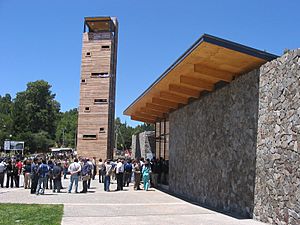Alto Biobío facts for kids
Quick facts for kids
Alto Bío Bío
|
||||
|---|---|---|---|---|

Ralco Museum
|
||||
|
||||
| Country | Chile | |||
| Region | Bío Bío | |||
| Province | Bío Bío | |||
| Alto Bío Bío | 25 August 2003 | |||
| Government | ||||
| • Type | Municipality | |||
| Area | ||||
| • Total | 2,124.6 km2 (820.3 sq mi) | |||
| Elevation | 973 m (3,192 ft) | |||
| Population
(2017 Census)
|
||||
| • Total | 5,923 | |||
| • Density | 2.78782/km2 (7.2204/sq mi) | |||
| Time zone | UTC-4 (CLT) | |||
| • Summer (DST) | UTC-3 (CLST) | |||
| Area code(s) | country 56 + city 43 | |||
| Website | Municipality of Alto Bío Bío | |||
Alto Biobío is a special area in central Chile. It is located in the Biobío Province, which is part of the Biobío Region. The total size of Alto Biobío is about 2,124.6 square kilometers.
What makes Alto Biobío unique is that most of its people (about 86%) are from the Mapuche Pewenche group. They live in 12 different communities along the Queuco and Biobio rivers. These communities are:
- Butalelbun
- Trap Trapa
- Mesh Mesh
- Cauñicu
- Pitril
- Callaqui
- Hazel
- Quepuca Ralco
- Aukin Wallmapu
- Ralco Lepoy
- Boat
- Guayali
Contents
People of Alto Biobío
This section talks about how many people live in Alto Biobío.
Population Numbers
According to a count in 2002, Alto Bío Bío had 7,027 people. About 1,094 people (15.6%) lived in towns, and 5,933 people (84.4%) lived in the countryside. The number of people living here grew by 31.2% between 1992 and 2002. In 2017, another count showed that the population was 5,923 people.
History of Alto Biobío
This part tells us about the past of Alto Biobío and its people.
Early Mentions
There isn't much old writing about this area or the Pehuenche people. Some small stories were written in the 1700s when Catholic missionaries set up forts here. These forts stretched from Rucalhue to Villucura and Santa Bárbara.
Travelers and Traders
More information was written about the Antuco area, which is nearby. This was a busy place for trade between the local people and the Creoles (people of Spanish descent born in Chile). Famous travelers like the Polish scientist Ignacio Domeyko and the German artist Mauricio Rugendas visited. They even drew the first pictures of the native people.
Times of Change
In the 1800s, the area became less peaceful. Chilean armies hunted down groups who were still loyal to Spain. There were also gangs of cattle thieves, like the Pincheira brothers, who caused trouble in Alto Biobío. A workers' protest in the eastern mountains also ended sadly with many deaths.
Pehuenche Isolation
Most of the time, the Pehuenche people lived quite isolated. They often traded their goods in Argentina instead of Chile. This was because it was easier to reach Argentina from their homes than to travel the long, winding road to Santa Bárbara.
Becoming a Commune
The area officially became its own commune, called Alto Biobío, on August 25, 2003. Before that, it was part of Santa Bárbara. The main town and capital of Alto Biobío is Ralco.
How Alto Biobío is Governed
Alto Biobío is a commune, which is a local government area in Chile.
Local Leadership
It is managed by a council and led by an Alcalde (mayor). The mayor is chosen by the people every four years. From 2008 to 2012, the mayor was Félix Vita Manqueti, from the PPD.
Border Zone Status
Because Alto Biobío is very close to the border with Argentina, it is considered a "border zone" by Chile's border agency.
Economy of Alto Biobío
This section looks at how people make a living in Alto Biobío.
Local Businesses
In 2018, there were 35 businesses registered in Alto Biobío. The main types of businesses included medium-sized stores selling food, supermarkets, and minimarkets. Other important activities were raising marine fish and primary education (schools).
Tourism in Alto Biobío
Alto Biobío has many beautiful places to visit and interesting cultural experiences.
Natural Wonders
The commune has amazing natural sights. You can see native plants and animals from the Andes Mountains. There are also two active volcanoes, Callaqui volcano and Copahue volcano.
Cultural Experiences
You can also learn about the culture of the 12 Pehuenche communities living here. The area focuses on "Community Tourism." This means visitors can experience the natural beauty and cultural heritage of the Pehuenche people. A big event for this was the 4th National Community Tourism Meeting in 2015.
Places to Visit
The main town, Ralco, has places to eat and stay. It also has an excellent Ralco Pewenche Museum where you can learn about the Pehuenche culture.
Some important attractions include:
- Callaqui volcano
- Copahue volcano
- El Barco Lagoon
- La Mula Lagoon
- Ralco Pewenche Museum
- Pirquinco Lagoon
Recent Events
This section covers important things that have happened recently.
Copahue Volcano Eruption
In May 2013, the Copahue volcano erupted. A "red alert" was announced, and people living near the volcano had to leave their homes for safety. The army helped with these evacuations, especially in the Ralco National Reserve area. The alert was lowered the next week, and since then, only "yellow alerts" have been issued, meaning there's a lower risk.
Notable People
- Nicolasa Quintremán (1939-2013), a famous activist from the area.
See also
 In Spanish: Alto Biobío para niños
In Spanish: Alto Biobío para niños



